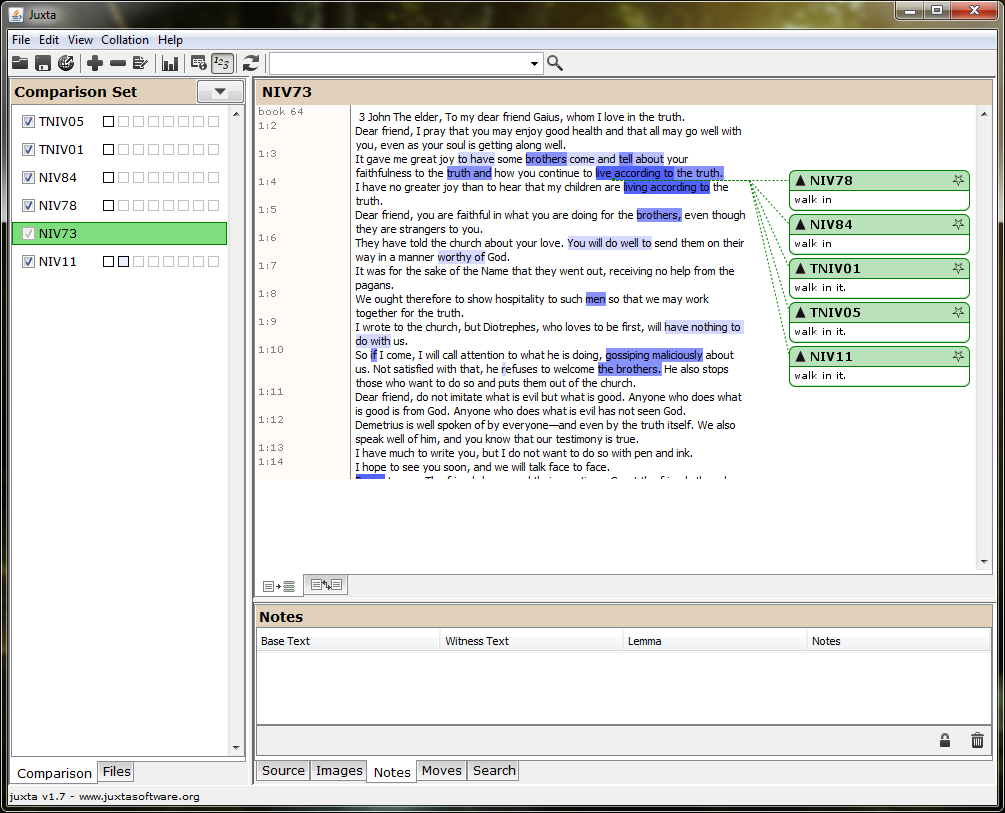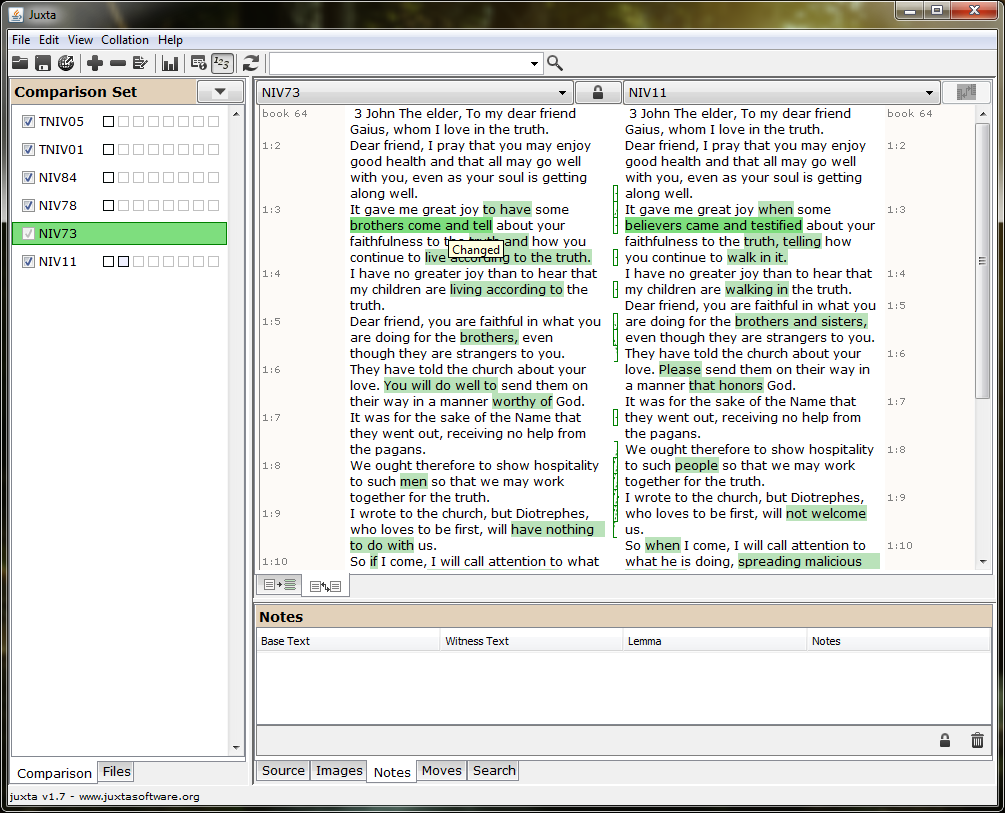In the beginning was the Word …
Last post, we covered the process of
- digitizing editions of the Bible that are only available in print,
- cleaning them up, and then
- formatting them so they can be machine readable and
- easily compared with other digital editions.
We also saw how the process isn’t so easy as 1-2-3-4!
But it is so worth it.
Now let’s catch a glimpse of the end result—the grand vision of what all this work is for.
The Purpose of this Project
My intent is that we won’t hesitate any longer to recommend or select a Bible translation to read and study.
The purpose of this massive project is two-fold:
- It is to hold Bible translations to account for the kinds of changes that translators have made to them from one edition to the next; and
- it is to give Bible readers (that’s you and me) an idea as to why those changes were made so we can test and approve those translations now currently in print (i.e., the Bibles we read and recommend).
My intent is that we won’t hesitate any longer to recommend or select a Bible translation to read and study.
Here’s how the collation process, and its critical apparatus can help:
Collating Texts
Collation is essentially the process of collecting things together for comparison. In the scholarly sense, the Oxford English Dictionary defines collation as a “[t]extual comparison of different copies of a document; the critical comparison of manuscripts or editions with a view to ascertain the correct text, or the perfect condition of a particular copy.”1 Collation also tends to include “[t]he recorded result of such comparison; a set of corrections or various readings obtained by comparing different copies.”2 This set of various readings is called a critical apparatus. Various readings include changes from one edition to another, such as emendations, omissions, insertions, etc.
Computer Help for Comparing Texts
The whole point of digitizing the biblical texts is to efficiently and easily compare between them using a computer automated process. We could still collate manually with hand and eye, but who wants to deal with limited human capacity for time and attention? Manual collation, the scholarly mainstay for centuries, required multiple pairs of eyes, many hours of time, and was still susceptible to our limits of fatigue and distraction.
Modern programmers and researchers have pieced together software tools to speed that process and ensure greater accuracy. One such set of software tools, the one I am using, is called Juxta.3 I value it because it is freely distributed and free to use. (Why pay more when we don’t have to, right?) Juxta’s features allow us to see changes between texts at a glance. See for yourself what it can do:

In this example, we have six editions of 3 John from the New International Version.4 The darker blue hi-lighting indicates where the greatest number of differences occur from the text displayed. The lighter blue hi-lights reveal changes that only show up in a fewer number of editions. Here, you can see how the NIV’s Committee on Bible Translation (CBT) changed the text of 3Jn 1.3 from 1973 to read smoother in later editions: From,
“It gave me great joy … how you continue to live according to the truth” (NIV 1973), to
“It gave me great joy … how you continue to walk in the truth” (NIV 1978), to
“It gave me great joy … how you continue to walk in it” (NIV 2011).
Perhaps you can figure out why they made the changes here that they did? Let me know what you think in the comments below.
In the next example, we can compare two editions side-by-side at a glance:

Note how the NIV 2011 edition (in the right column) differs in its use of gender language, vocabulary, and verb form from the NIV 1973 edition in the same verse: From,
“It gave me great joy to have some brothers come and tell about your faithfulness …” (NIV 1973), to
“It gave me great joy when some believers came and testified about your faithfulness …” (NIV 2011).
Why do you suppose the CBT changed the vocabulary and verb form? Tell me in the comments below.
Making a Report and Producing a ‘Critical Apparatus’
What we’ve seen so far is fascinating, but it’s only available to those who have all these resources at their fingertips. The final step is making this information generally known and available. One way is to publish what is called a critical apparatus, which we defined as a set of variant readings. It’s a concise list of all those changes, insertions, omissions, transpositions, etc., showing where they occur by chapter and verse and in what edition of each text. Our Juxta software can generate one when all the texts are collated. Here’s the final result:
NIV 1973 ] NIV 1978, NIV 1984, TNIV 2001, TNIV 2005, NIV 2011:
1:3 to have ] when NIV11
1:3 brothers ] believers TNIV01, TNIV05
1:3 brothers come and tell ] believers came and testified NIV11
1:3 tell about ] testify to TNIV01, TNIV05
1:3 truth and ] truth, telling TNIV01, TNIV05, NIV11
1:3 live according to ] walk in NIV78, NIV84
1:3 live according to the truth. ] walk in it. TNIV01, TNIV05, NIV11
1:4 living according to ] walking in NIV78, NIV84, TNIV01, TNIV05, NIV11
1:5 brothers, ] brothers and sisters, TNIV01, TNIV05, NIV11
1:6 You will do well to ] Please NIV11
1:6 worthy of ] that honors NIV11
1:8 men ] people TNIV01, TNIV05, NIV11
1:9 have nothing to do with ] not welcome NIV11
1:10 if ] when TNIV01, TNIV05, NIV11
1:10 gossiping maliciously ] spreading malicious nonsense TNIV01, TNIV05, NIV11
1:10 ^even NIV11
1:10 the brothers. ] other believers. TNIV01, TNIV05, NIV11
1:14 /Peace ] Peace NIV78, NIV84, TNIV01, TNIV05, NIV11
Starting on the very left is our chapter & verse in 3rd John where our variants occur. To the left of the “]” (square bracket) is the base text, the text we are comparing the later editions against. Here, we are comparing against the NIV 1973 edition. To the right of the “]” is the variant reading found in a later edition (or editions, pl.) followed by what edition(s) that reading is found in. For example:
1:3 to have ] when NIV11
Here, verse 3 reads in the earlier 1978 edition, “It gave me great joy to have … “. After the square bracket (“]”) we see that “to have” was changed, “It gave me great joy when …”. We see that this change occurred in the latest 2011 edition only (NIV11).
Now, for a more complex example:
1:4 living according to ] walking in NIV78, NIV84, TNIV01, TNIV05, NIV11
We can see that the 1973 edition reads “living according to [the truth]”. The apparatus reveals that next edition (1978) changed it to read “walking in [the truth]”, and that change has stayed with every following edition.
The next example reveals that the 2011 edition inserted a word (“even”) to smooth out the reading in 3Jn 1.10:
1:10 ^even NIV11
It now reads, “he even refuses to welcome other believers …” (Nice guy, huh?)
This final example demonstrates a curiosity that wants further investigation:
1:14 /Peace ] Peace NIV78, NIV84, TNIV01, TNIV05, NIV11
What’s happening in 3Jn 1.14 when a change is noted but not apparent? Well, fact is, the 1973 edition actually marked an additional verse! It contained 15 verses, not 14 like all later editions. No words were taken away in later editions, but the verse 15 reference number was dropped, and the words in verse 15 were combined in verse 14 for all later editions.
What revelations and insights has this critical apparatus given you? If you have an observation or a particular textual question for me to research, let me know in the comments below.
Notes:
- “collation, n.”. OED Online. December 2016. Oxford University Press. http://0-www.oed.com.catalog.multcolib.org (accessed February 20, 2017).
- ibid.
- Juxta was developed by the Applied Research in Patacriticism (ARP), a digital humanities lab working out of the University of Virginia, and was funded by the Andrew W. Mellon Foundation.
- NIV 1973, which is displayed; NIV 1978; NIV 1984; Today’s New International Version (TNIV) 2001; TNIV 2005; and NIV 2011.

Leave a Reply